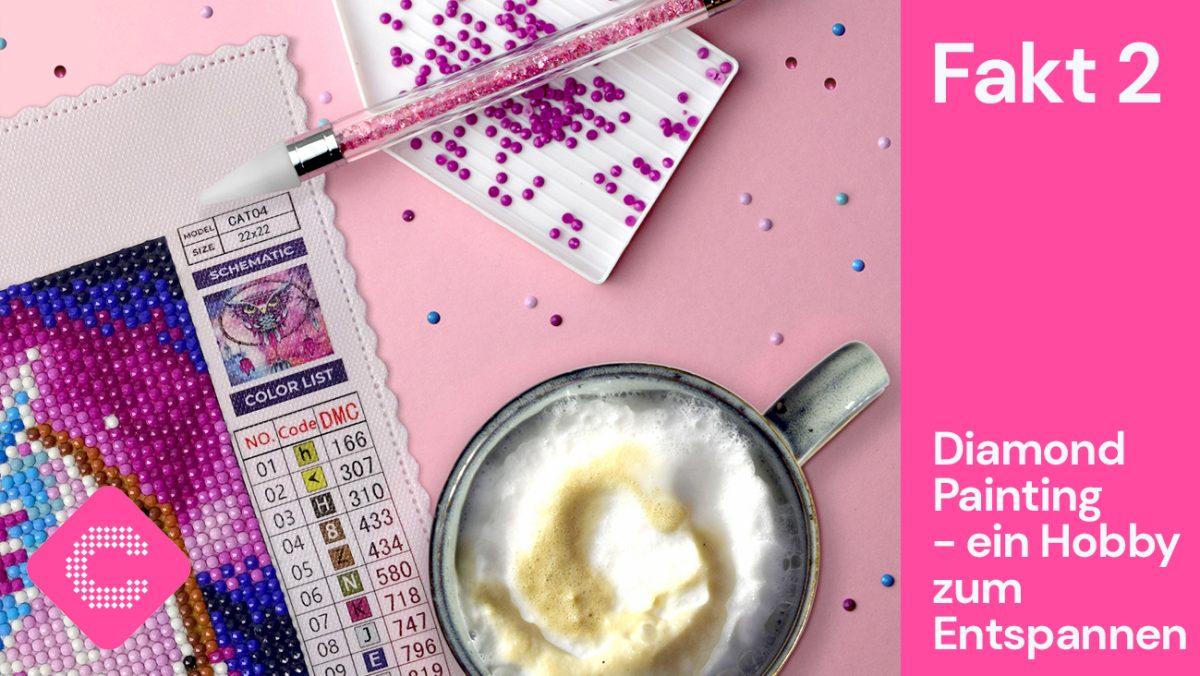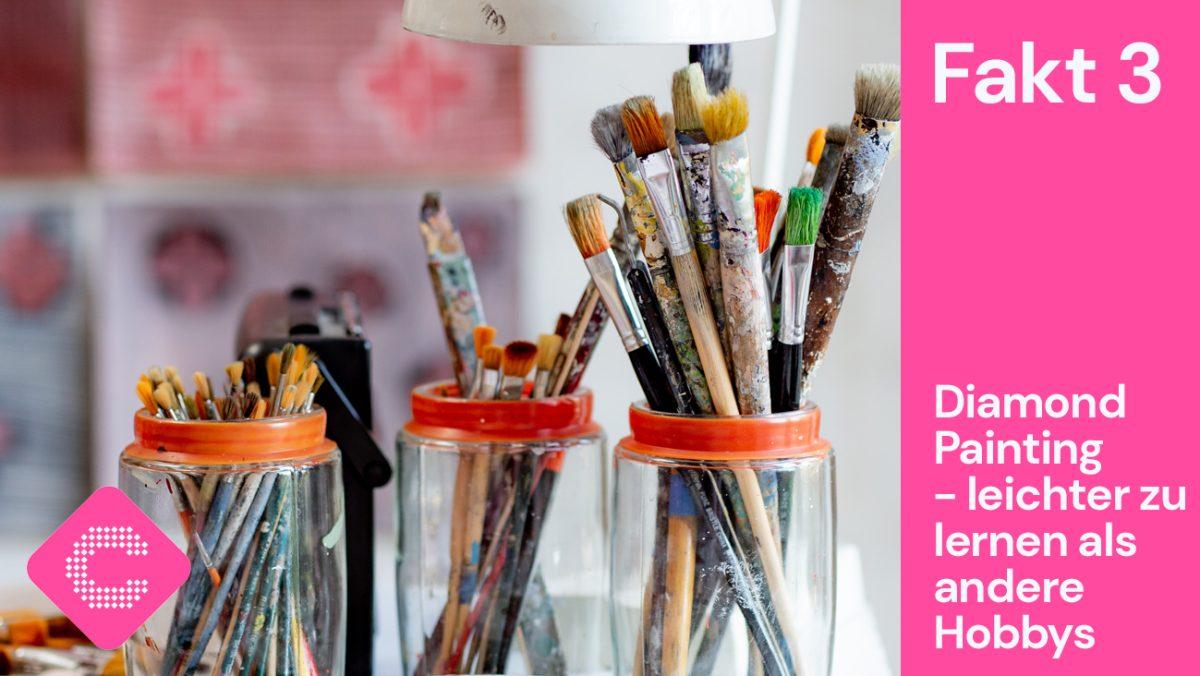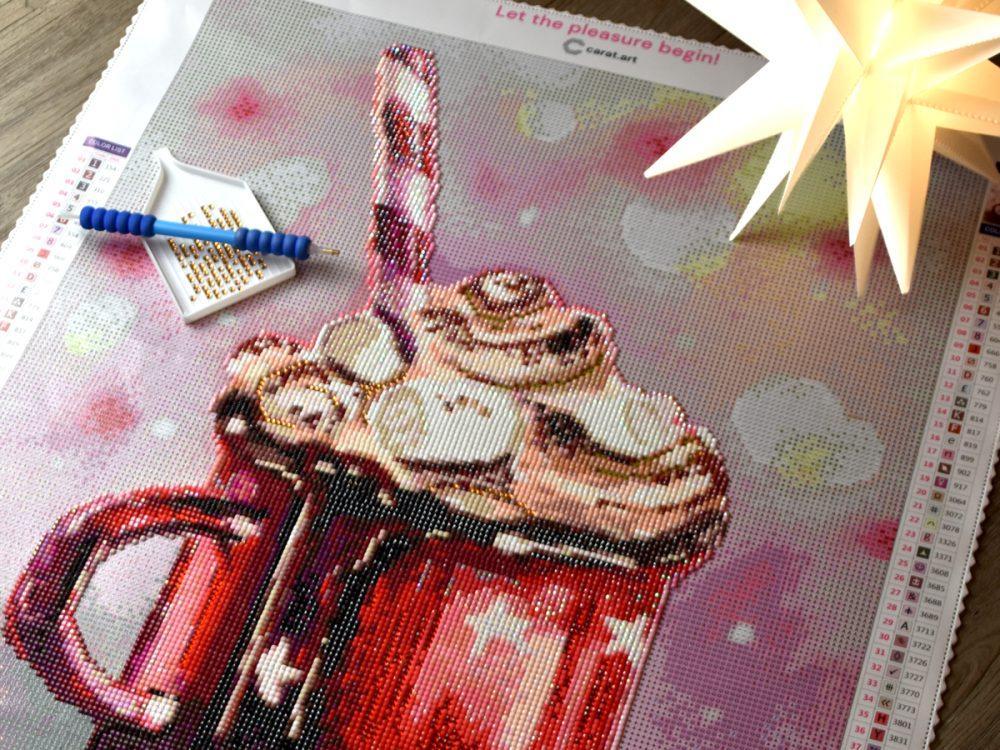Diamond painting as a DIY trend
The big DIY trend used to be called “painting by numbers” – today it’s called Diamond Painting. Some would call it a modern form of mosaic or puzzle, others it reminds them of cross-stitch pictures. This is probably because Diamond Painting combines many of the basics of various creative pastimes, and a fascinating new form of creative activity has been invented that is not only completely uncomplicated to do, but also produces beautiful results. Not only does the activity of diamond painting involve a certain amount of craftsmanship and creativity, but the activity also offers amazing relaxation mechanisms.
The up-and-coming DIY trend and all its positive qualities have definitely convinced us and inspired us to launch our company Carat Art. Today, we would like to introduce you to 10 exciting facts about diamond painting that may be new to you.
1. The origin of diamond art
Unfortunately, despite extensive research, we cannot name a specific inventor or place. What is certain, however, is that the origin of this craft is very old and lies in the Asian region. Its beginnings probably go back to an ancient tradition of gluing beads and similar materials onto velvet or felt to form patterns and ornaments. Nowadays, a canvas is used as the backing and, of course, the associated technical methods have also become more modern. Printed canvases including a special adhesive in the form of a self-adhesive surface, so that the diamond stones can form a permanent bond with the canvas, are now the basis of modern diamond painting, with which anyone can easily create beautiful works of art. The first diamond painting sets of the kind we know today came onto the market in China in 2015 and have since taken the DIY scene worldwide by storm.
2. The positive effects of diamond painting
At first glance, this DIY hobby seems to be all about creating a visually appealing picture with a simple procedure. In fact, behind the seemingly simple activity of gluing on stones, there are more far-reaching aspects with many positive effects. While you’re busy adding pebble after pebble, you’re also developing motor and mental skills, which have other benefits. While you keep your hands and brain busy with the structured and repetitive process of picking up and placing bricks, your mind can rest. For this reason, many people use painting to relieve stress and relax. It is an ideal compensation after a hard day at work and can distract and calm people who are prone to anxiety or inner restlessness. It is not for nothing that diamond painting also finds its place in art therapy. Diamond Painting is ideal for finding a balance to the hectic and often stressful everyday life. The occupation with the small stones has an extremely calming effect on body and mind and thus leads to a state of deepest relaxation. All fears, worries and problems can be banished from your thoughts, as only the moment and the diamond image are perceived. Working with the glittering stones not only creates beautiful pictures, but the sorting and gluing of the stones also has positive effects on your whole life in many ways.
And although the motif and pattern are already predefined on a canvas, working on a diamond painting still trains your imagination and creativity. Likewise, your fine motor skills are trained and improved through the individual steps required. In addition, diamond painting also satisfies the psychological reward system in the brain – individual completed sections and, of course, the finished picture at the end give you a strong feeling of satisfaction. Not to forget, it promotes discipline and patience, which such work demands from you.
Moreover, painting with diamonds is not an activity that you can do all by yourself and for yourself. If you wish, you can share your artistic work with others.
Especially large or multi-part motifs such as our “Elephants in the sunset” or “A morning in Paris” are particularly suitable for working on with several people at the same time. The whole family can even help out and spend some quality time together. Finally, you can hang the finished work of art together and decorate the walls of your home individually.
3. Particularly easy to learn & to master
When painting by numbers, you need a steady hand and enough practice to draw the brush correctly and safely over the lines and squares for the result to be appealing. Freehand painting or drawing is even more difficult, as you need not only a lot of practice but also a certain talent and plenty of spatial imagination. Often, however, the result is not what one had imagined, which is disappointing and demotivating. There is also a high potential for mistakes in pottery, clay, embroidery, crochet and many other creative leisure activities. In addition, many creative hobbies require lots of equipment, utensils, space and often years of practice to achieve beautiful results. Painting with diamonds, on the other hand, does not require any extraordinary skills or artistic experience, especially because of the easy-to-understand principle. You only need time, a systematic approach, patience and a little intuition to get closer to the completion of your individual work of art, stone by stone. Through different sizes and several diamond shapes, you can also create diamond paintings in different levels of difficulty and through the selection of infinitely different motifs, it will never be boring!
4. Not all drills are the same
The little Diamond Painting Stones are available in different colours, shapes, sizes and materials.
- In total, there are about 450 different colours, each with a name and its own individual number, the so-called DMC code.
- As a standard, diamonds are available with either a square or a round basic shape, whereby the square ones have a side length of 2.5 mm and the round ones have a diameter of 2.8 mm.
- In principle, both round and square stones are available in two different materials: resin (resin) or acrylic, which is cast into the corresponding mould by means of special machines.
- In addition to the round and square shapes, there are also special shapes (drops, hearts, etc.).
- The special shapes are mostly rhinestones, which have a very special & sparkling effect and look like glass. They are available in different sizes (1mm to > 25mm). Square and round stones are also available in rhinestones.
- The round and square diamond stones are also available in various special designs
- AB stones: Due to an additional coating, their surface shimmers in different iridescent colours. This makes them shine and glitter even more in the light. The abbreviation AB comes from “Aurora Borealis”, as their shimmer is reminiscent of that of the northern lights in the polar sky.
- Diamonds with a “glow in the dark” effect. They can be used to highlight parts of the picture or hide secret writing that can only be seen in the dark. In normal light, these stones are usually white-greenish.
- New are also stones with a metallic effect in gold, silver, iron and bronze optics.
5. The number of diamonds in a set
The total number of diamonds included in a set will, of course, always depend on the size of the canvas. There may be tens of thousands of diamonds on a large-sized canvas. For round diamonds with their diameter of 2.8mm, the quantity of diamonds on a surface can be calculated using the following formula: Picture width in cm x picture height in cm x 12. For a smaller picture of 30x40cm, this gives a total number of 14,400 little stones and for a large picture of 50x70cm, the impressive figure is 42,000 little stones.
As square diamonds are a little smaller with their side length of 2.5mm, pictures with square diamonds automatically contain a larger amount of diamonds per set. The formula to calculate this is as follows: Picture width in cm x picture height in cm x 16. This means that a smaller picture of 30x40cm already has a total number of 19,200 little stones and a large picture of 50x70cm has an impressive 56,000 little stones.
6. The difference between 3D and 5D
When selecting products, you have probably already noticed the terms 3D and 5D Diamond Painting. If you have ever wondered what these terms are supposed to mean, here comes the explanation: it is not about different spatial dimensions of perception, but about the facet cut of the stones. This marking is a reference to the way the stones are made and the nature of the stones. 3D diamonds have 3 facets on each side, while 5D diamonds have 5 facets on each side. The difference is therefore in the number of facets.
When light hits the diamonds, it is reflected back by the facets, which causes the diamonds to sparkle and shine, and the more facets a diamond has, the shinier and sparklier it appears. For this reason, high-quality diamond painting manufacturers now only use 5D diamonds for their diamond paintings.
7. Not just for adults
Advertisements sometimes give the impression that diamond painting is only for adults, but this craft trend is great fun for young and old alike. Especially because this great leisure activity also trains many important skills along the way, diamond painting is a great employment idea especially for children. Activities in which children not only have fun, but which encourage them in a playful way are particularly important for child development. Diamond Painting DIY sets are proven to not only be a lot of fun for children, but at the same time diamond painting supports skills such as:
- Fine motor skills
- Concentration
- Endurance
- Attention to detail
- Colour perception
- Dexterity
When children can proudly hold their own sparkling diamond painting in their hands at the end of their DIY project, it is a valuable experience that strengthens self-esteem and has a positive effect on their development. What’s more, the end result can be presented as a sparkling Diamond Painting picture on the wall of the children’s room for everyone to admire!
We therefore offer extra small and particularly cute Diamond Painting Mini Sets especially for children, with which quick successes can be achieved and which, with their cute motifs, are a great gift idea for children who love handicrafts.
8. Diamond Painting Storage
Whether you want to store your DIY sets while you haven’t worked on them yet, temporarily store them while you work on them, or if you are looking for a solution to what to do with your finished diamond paintings, for all these questions there are several possible solutions to choose from.
Unprocessed images can of course be stored in the original box for as long as you like. In this box, the images are neatly rolled up and safely protected against dust and damage. However, some people prefer to store their images unwrapped to keep them nice and flat. If you also prefer this solution, you can store your canvases either in a large art folder or in large-format boxes and store them, for example, under the bed or on top of a cupboard.
If you need to store a painting you are working on, you can always roll it up and store it in its original box. Just make sure that the protective film is properly reapplied so that the adhesive surface is not contaminated. It is also important to always roll up the canvases with the diamond side facing outwards so that the diamonds that have already been glued on are not pressed together.
Started diamond paintings can also be hung on hangers with clips for trousers and thus be stored smoothly and space-saving on a clothes rail in the wardrobe. Even with this storage method, you should always make sure that the protective film covers the adhesive surface that has not yet been applied. Of course, Diamond Paintings that have been started can also be stored flat in art folders or boxes.
Of course, there is nothing better for finished diamond artworks than to frame them and decorate your walls with them. There are different types of frames that you can use for finished Diamond Paintings. Either you can opt for simple pre-made standard frames, which can be bought everywhere in different sizes and styles. This way, the glittering artwork is protected from dust and dirt behind the glass frame. Otherwise, stretcher frames can also be used for framing. These are made of wood and the canvas has to be stretched on them, wrapped around the stretcher and fastened from behind with nails. Alternatively, you can also glue your diamond artwork onto stretcher frames that are already covered with canvas. It is particularly quick and easy to make a diamond picture ready for hanging with the help of magnetic frames. These frames consist of pairs of wooden strips that clamp the canvas between them at the top and bottom by means of magnets and can be easily hung up by means of a cord on the upper pair of wooden strips. This type of frame also allows you to quickly exchange a work of art and replace it with another.
If you do not want to frame your Diamond Painting, you can also store finished pictures safely in art folders or boxes. If you like to paint a lot but don’t have room in your home for more artwork, you can also sell your finished paintings to diamond painting lovers via platforms such as Ebay, Etsy or Facebook.
9. Cast adhesive and adhesive film
Anyone who has already done one or two Diamond Painting motifs and is looking for new projects will sooner or later come across the terms: double-sided adhesive tape and poured glue. This refers to the adhesive surface on the canvases to which the diamond stones are applied. But what exactly is the difference between these two different types of glue and which method is better?
The first method of applying an adhesive layer to the canvas surface is double-sided adhesive tape. Here, depending on the size of the canvas, two or more strips of transparent double-sided tape are stuck to the printed canvas. However, double-sided adhesive tape unfortunately tends to curl and unsightly air bubbles often form. In addition, once the stones have been placed, they can hardly be moved afterwards without damaging the adhesive tape. The adhesive of the double-sided tape is also not very durable. Diamond Paintings with double-sided adhesive tape can therefore not be stored well or for a long time, as they will lose their adhesive power.
The other method of applying the adhesive to the canvas of Diamond Paintings is to pour a liquid adhesive mass onto the canvas and spread it thinly and evenly. This poured adhesive layer bonds well with the canvas, retains its adhesive strength in the long term, does not dry out and remains slightly elastic. For this reason, incorrectly placed stones can easily be moved or removed again without damaging the adhesive surface. With this method, no air bubbles form in the adhesive surface and any wrinkles in the canvas smooth themselves out over time due to the elasticity of the adhesive. Moreover, canvases with cast adhesive can be stored for a longer period of time without losing their adhesive strength.
So in general, cast adhesive has many advantages over double-sided tape, making it not only higher quality, but also more popular.
Whether you are a Diamond Painting beginner or a professional, it is worthwhile when buying a Diamond Painting to make sure that the manufacturer uses cast adhesive and not double-sided tape. Above all, anyone who would like to buy a stock of Diamond Paintings would be well advised to make sure that they only buy canvases with cast adhesive for this purpose, as this is the only adhesive method that can guarantee that the adhesive strength will be maintained for a long time and that no unsightly storage marks such as cracks, air bubbles or creases will form.
In our Diamond Painting Shop we exclusively sell paintings with cast adhesive.
10. Sealing the finished Diamond Painting
If you want to enjoy your self-created work of art for a long time or if you are in doubt about the quality of the adhesive surface, you still have the option of sealing your work of art after it has been completed. For this purpose, an appropriate agent is applied with a brush or distributed through a spray can, which significantly increases the durability and lifetime of the gloss. Sealing is not absolutely necessary for Carat Art products. Both the adhesive surface and the stone quality are of high quality and long-lasting.
If you still want to seal your Diamond Painting, you do not need any expensive special products for this, because conventional latex bonding agent from the DIY store works just as well.







